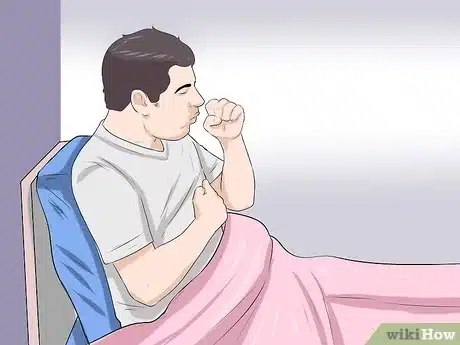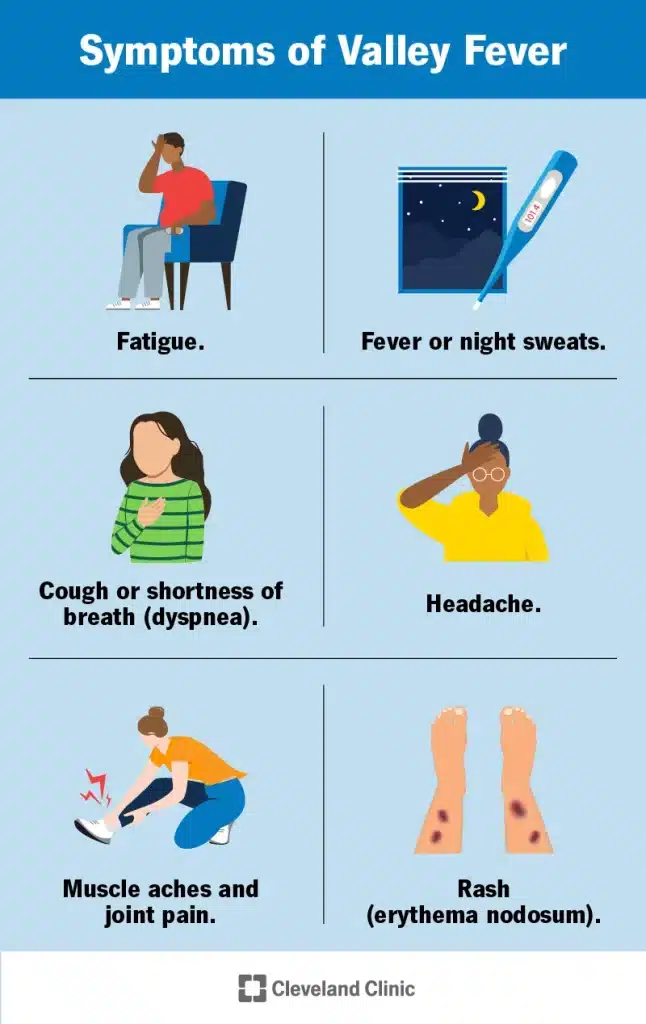
Valley Fever is a fungal infection that is transmitted by spores that live in the soil. These spores are present in many areas of the world, but California and Arizona have the highest rates of infection due to their warm, dry climates. Valley Fever is most common in the areas where these spores are most prevalent, but cases have been reported all over the United States. If you have been diagnosed with Valley Fever, it’s important to take steps to prevent spreading the infection to others.
In this article, we’ll talk about Valley fever, its symptom, and how it diagnoses and treated.
About Valley Fever

Valley fever is a fungal infection caused by inhaling spores of the fungus Coccidioides. This disease is an infection caused by a fungus that grows in the soil and spreads through the air. It affects people who live in or have traveled to areas where the fungus is common, such as the southwestern United States and parts of Mexico, Central America, and South America.
The fungus can live in the soil for years without causing any symptoms. However, when it gets into your body, it can cause symptoms such as cough, fever, and chest pain. In some cases, this fever can lead to pneumonia or meningitis.
Symptoms of Valley fever

The symptoms of the disease include fever, cough, and difficulty breathing. While not everyone who contracts valley fever will experience symptoms, those who do will usually develop them within two weeks of exposure to the fungus. In rare cases, this fever can be fatal if left untreated in people with compromised immune systems or other health issues such as diabetes or HIV/AIDS.
This fever is a fungal infection that can cause a variety of symptoms, including:
- Fever
- Cough
- Shortness of breath
- Fatigue
- Chills
- Chest pain
- Headache
- Rash
- Night sweats
- Muscle aches or joint pain
It is important to note that not all individuals with Valley fever will experience symptoms, and some may only experience mild symptoms that resolve on their own. “However, it is still important to seek prompt medical attention if you believe you may have contracted the infection, as early treatment is key to managing symptoms and preventing complications,” Landry adds.
How to test for Valley fever

Healthcare providers rely on your medical and travel history, symptoms, physical examinations, and laboratory tests need to diagnose Valley fever. The most common way that healthcare providers test for this fever is by taking a blood sample and sending it to a laboratory to look for Coccidioides antibodies or antigens. Valley fever is difficult to diagnose based on the signs and symptoms because symptoms are usually vague and similar to those that occur in other illnesses. Even a chest X-ray can’t help doctors see the difference between valley fever and other lung diseases.
To diagnose this specific fever, doctors may order one or more of the following tests:
- Sputum smear or culture. These tests check a sample of the matter that’s discharged while coughing (sputum) for the presence of coccidiosis organisms.
- Blood tests. Through a blood test, your doctor can check for antibodies against the fungus that causes valley fever.
If doctors think you may have pneumonia associated with valley fever, they may also order imaging tests, such as a CT scan, MRI, or chest X-ray. If needed, doctors may remove a sample of tissue from the lungs for testing. In some cases, doctors may do a skin test to find out if you’ve had valley fever in the past and have developed immunity.
Is Valley fever contagious
Valley fever is not contagious and cannot be spread from person to person. However, it can be spread through the air by breathing in dust from soil containing the fungus that causes valley fever. You can’t catch it from other people, or by touching or breathing in spores that are shed into the air by infected animals or humans. You can only get it by breathing in the spores of the fungus. The spores are found in the dust kicked up by wind or construction projects, or carried on infected people’s shoes or clothes. If you have an open cut or wound, you may also be more likely to get a fever if you’re exposed to the fungus.
Who is most likely to get valley fever
People who are at higher risk for becoming severely ill, such as those with weakened immune systems, pregnant people, people with diabetes, and Black or Filipino people, are advised to avoid breathing in large amounts of dust if they live in or are traveling to places where this fever is common.
How can I prevent valley fever

Valley fever is a fungal infection that can affect people of all ages, but it’s most common in people who live in or have visited the Southwest United States. It can be spread through soil and dust particles that are blown around by the wind, so outdoor activities like gardening and construction can increase your risk of exposure. Valley fever can be prevented by taking precautions in areas where it is common. When traveling to an area with endemic valley fever, avoiding contact with soil and dust can help prevent infection.
Here are some tips on how to prevent valley fever:
- Wear a face mask, such as an N95 respirator
- Stay inside during dust storms
- Avoid outdoor activities, such as yard work and gardening, that require close contact with dirt or dust
- Use air filtration systems while indoors
- Clean skin injuries with soap and water
- Take preventive antifungal medication as recommended by your doctor. The antifungal drugs fluconazole (Diflucan) or itraconazole (Sporanox, Onmel, Tolsura) are generally used for all but the most serious forms of coccidioidomycosis disease.
Is there any vaccine for Valley fever

Valley fever is a fungal infection that can cause severe pneumonia and other complications. Although there’s no vaccine to prevent it, the CDC recommends taking precautions if you live in or visit an area where valley fever is common, such as Arizona and California. According to the CDC, scientists have been working on a vaccine to prevent valley fever. However, researchers at the University of Arizona College of Medicine in Tucson have created a two-dose vaccine that’s been proven effective in dogs.
Conclusion
Valley fever is a disease that can be fatal if not treated properly. It is caused by the fungus Coccidioides immitis and is spread through inhalation of airborne spores from the soil. The disease can affect anyone, even healthy people. If you think you have valley fever, it is important to see a doctor right away so they can treat it before it becomes too serious. We hope this article has helped clarify what valley fever is and how it affects people who are at risk for infection.











